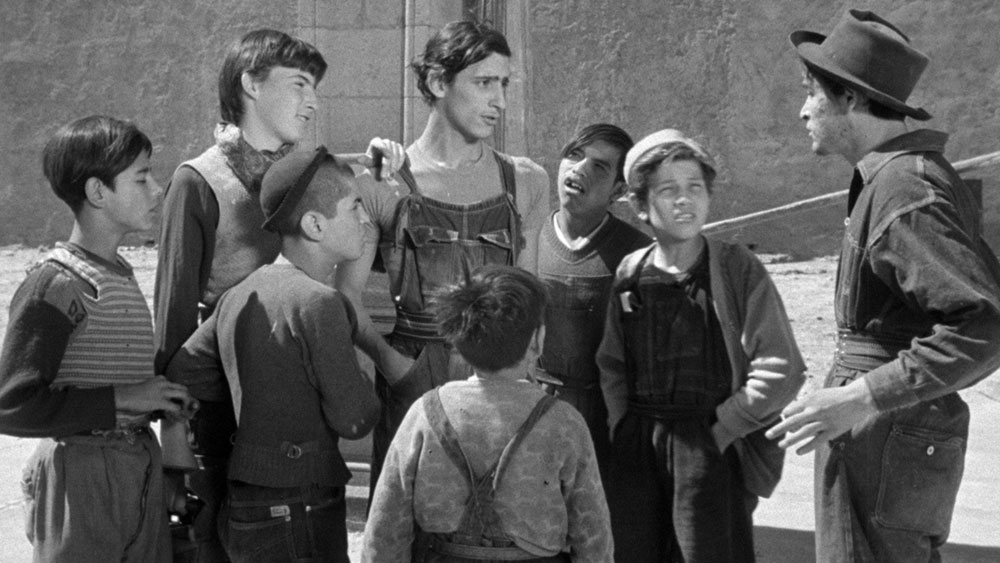Luis Buñuel’s Los Olvidados (1950) starts with a narrator saying: “Almost every capital like New York, London, Paris, hides behind its wealth poverty stricken homes, where poorly-fed children, deprived of health or schooling, are doomed to criminality.” The voice-over is accompanied by a suspenseful soundtrack and shots of the Eiffel tower, London’s polished canals, and New York’s skyline. “The future isn’t shackled to the present: the day will come when the rights of children are respected. Mexico City, a large modern city, is no exception to the rule. This film shows life as it is. It’s not optimistic,” the narrator concludes.
Buñuel’s cinema is about the possibility of counter-narratives, such that the documentation of life as it is alongside dreamlike representations of life rupture official narratives relating to national identities. In surrealist fashion, Buñuel made use of uncanny symbols and delirious imagery to reject the totalizing discourses of rationality present in the state and religious doctrines of his era. His unyielding images in Los Olvidados anticipate the political fury of the Latin American filmmakers who became associated with similar forms of revolutionary filmmaking in the ensuing decades.
In Los Olvidados, Buñuel follows the neglected Pedro (Alfonso Mejía) and the orphaned El Jaibo (Roberto Cobo) through a bleak coming-of-age story. They both reflect the abandonment Mexico’s citizens felt from their government in the aftermath of World War II. While Mexico presented itself as a paragon of Third World development following the war, its economy favored its growing middle class and ignored both low-paid urban workers and the rural poor. Throughout the film, Buñuel shows the boys in tattered clothes and constantly dealing with their drunk and neglectful parents. While Jaibo is the most cunning and fearsome of them, all the boys end up vying for a lick of power, a few pesos, or a cigarette; they are not interested in carrying out justice when they can, and prefer to work on improving their groups’ social status above that of other groups in their environment
We first meet the titular group of boys outside Mexico City’s main square. Buñuel places the viewer in the middle of their roughhousing game: the smallest boy scales a pillar, as if to keep watch; another, with missing front teeth, honks like a pig; and the rest role play as matadors using ragged sweaters as their flags. As one of the boys passes out cigarettes, their clamorous chatter comes together like a chorus, as if they are a collective cacophonous unit. Buñuel presents the group as a regime of uncertainty. The boys are resolute about their routine get-togethers but their interactions with one another are explosive from the start. Jaibo, who has just returned from prison at the film’s beginning, immediately starts issuing orders upon regrouping with the rest of the boys. “You’re no good without me,” he flaunts. “If you all obey my orders, we’ll get dough.” His return to the streets is the talk of the town: he lurks at every corner, mugs the weak and vulnerable, and he often appears at Pedro’s home and workplace unannounced. Jaibo represents systemic violence produced by neglect. He is not only a character, but a vessel for Buñuel to explore society’s violent pleasures. It is through Jaibo that Los Olvidados’s themes—the voices of the unheard, the negotiations of power in everyday survival, incarceration and social programming, errantry, masculinity and pride—emerge.
While Los Olvidados is made in the style of neorealist film, no Buñuel film is complete without surreal sequences. As Pedro sleeps after witnessing Jaibo murder his enemy Julian, he dreams of his mother slowly rising from her bed in a long white nightgown as though she were a ghost. Buñuel slows down her movement to a molasses tempo while her expression is deceitfully warm. The effect does not only convey Pedro is dreaming, but also distorts the viewer’s sense of time. Then, Julian’s dead hand reaches out from the bottom of the frame and interrupts Pedro’s mother from walking over to his bed and caressing him. Pedro quickly gazes out with terror as a bird flies in from the sky and Jaibo also appears to prevent his mother from comforting him. Buñuel is not only interested in revealing the violence present in these boys’ lives, he is intent on showing his audience, which is hungry to be entertained by scenes of poverty, that there is no real consumptive narrative to make sense of marginal spaces, neither in dreams or reality.
At the end of the film, Pedro is killed by Jaibo. A grandfather and granddaughter discover his body and deposit it at the edge of a cliff. The camera gradually pans toward the night sky. The last shot is conspicuously dark and unpeopled, as though Buñuel wants to stretch his ending into the afterlife. While there is clearly an ending for Pedro, Buñuel’s non-ending leaves the viewer involved in this tragic story, as though mocking their desire to effect social change.
Los Olvidados screens this afternoon, February 18, at the Museum of Modern Art as part of the series “Buñuel in Mexico.”



